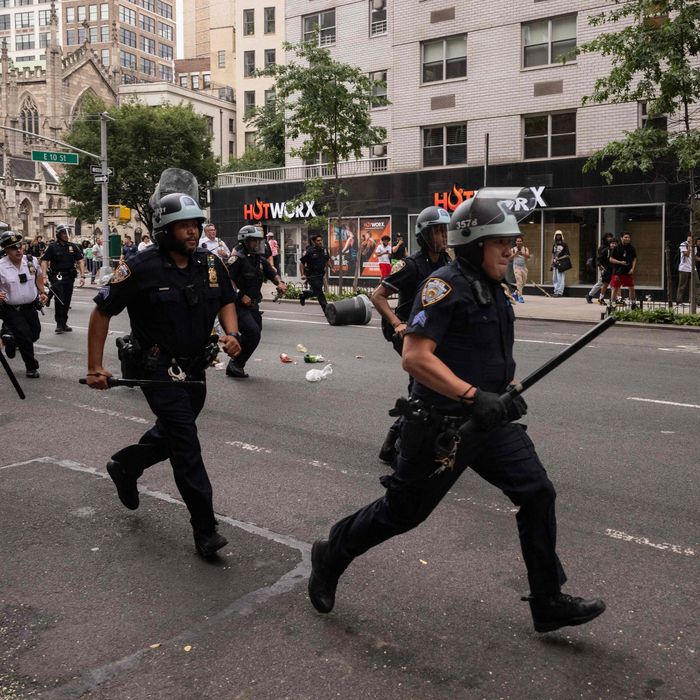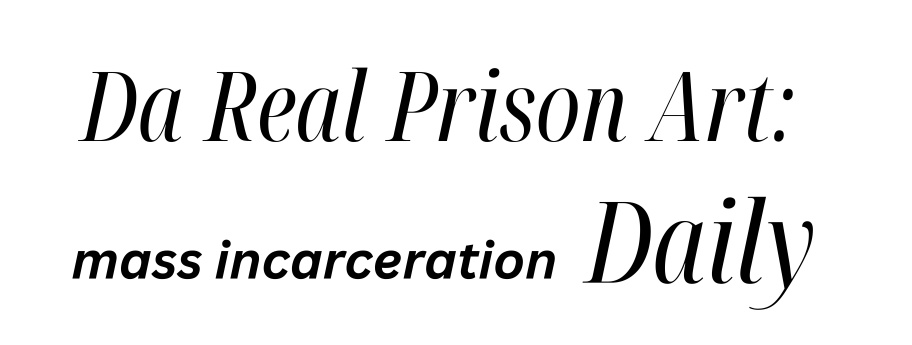
Photo: YUKI IWAMURA/AFP via Getty Images
If an alien’s only window into American politics were left-of-center social media, they would conclude that there is exactly one urgent question facing critics of the nation’s criminal legal system today: Should police and prisons exist at all?
Late last month, the New York Times’s Jane Coaston tweeted, “I’ll take prison abolition seriously when they do.” By this, Coaston meant that the refusal of many abolitionists to provide clear, comprehensive answers to the most obvious objections provoked by their ideal rendered them fundamentally unserious. Many abolitionists took umbrage at Coaston’s condescension, insisting that her queries about how the state would ensure public safety in the absence of law enforcement or criminal detention were extensively addressed in their literature.
On social media, questions that separate the extremely left wing from the very left wing tend to galvanize more debate than, say, questions that actually have political relevance in the contemporary United States. A bunch of people who agree that America’s prison sentences are far too long, that its police departments are far too unaccountable, and that its disadvantaged communities are far too deprived of resources and public services have spent the past couple weeks denouncing each other online.
For my part, I think we are always going to need state institutions that enjoy a monopoly on violence and use it to enforce laws, along with other state institutions that isolate the violent from the broader public and seek to rehabilitate them. In an ideal society, these institutions would bear little resemblance to contemporary American policing and prisons. But police and prisons are nevertheless the most commonly understood words we have for describing these two types of institutions. Thus, anyone who recognizes the need for state systems of law enforcement and rehabilitation, and wishes to communicate clearly to a mass public, should not call for the abolition of policing or prisons.
I’ll elaborate my reasoning on those points below. But I also think that what abolitionists get wrong is less important than what they get right. So it’s worth saying a bit about the latter. After all, the corrupt systems that such abolitionists inveigh against have immense power, while they have scarcely any.
There are (at least) six important things that abolitionist scholars and activists are right about:
(1) America’s approach to criminal justice is excessively retributive. As I wrote yesterday in an article about Ashton Kutcher and Mila Kunis, the punishment of lawbreakers can serve three purposes: to deter others from breaking the law, to incapacitate a lawbreaker who is liable to reoffend until they are rehabilitated, and to enact retribution on behalf of those harmed by the lawbreaker.
Abolitionists insist that this third purpose is illegitimate. In their view, systems of justice should seek to reduce harm, not to reallocate it to those who supposedly deserve it. And yet America’s penal system is at least as focused on retribution as it is on deterrence or incapacitation.
They’re right about this.
My own opposition to retribution is rooted in skepticism of free will and a commitment to the minimization of suffering. To no small degree, our thoughts and actions are products of forces outside the control of our conscious selves. People generally understand that accidents of birth can increase a person’s likelihood of ending up involved in crime. There is a reason why individuals born into impoverished communities where violence is commonplace offend at higher rates than those born into prosperous and peaceful neighborhoods. But even beyond these overt sociological factors, the very structure of our personalities — our capacity to manage anger and control impulses — is influenced by genetic and environmental factors we did not author.
This doesn’t mean that we can’t hold people morally culpable for their actions. But it does mean that punishment can be justified only on pragmatic grounds. If imposing consequences on criminal offenders causes them and others to perpetuate less harm, then those consequences are justified. But if a conscious subject has no fundamental agency over their actions, since those actions are at bottom determined by forces outside their control, then there is no justice in imposing suffering on that subject for its own sake.
To be sure, you don’t need to reject free will to arrive at this conclusion. You could simply believe that suffering is bad and should be minimized. If so, then subjecting an individual to the suffering of incarceration can be justified only if doing so reduces the sum total of all suffering (say, by preventing that individual from harming others).
From this perspective, deterrence and incapacitation are legitimate functions of a criminal-justice system, but retribution is not. Yet America’s approach to incarceration is more draconian than necessary for deterring and incapacitating victimizers.
Prison sentences in the United States tend to be much longer than those of peer nations. As of 2019, 773,000 people were serving sentences of over ten years in a U.S. prison. Yet criminological research indicates that sentence length has little impact on deterrence. Before an individual decides to commit a crime, they do not generally Google their state’s criminal statutes, determine whether their prospective crime carries a 10 or 20-year sentence, and then conclude, “Well, since it will only cost me a decade of my life instead of two, I’m going to go ahead with this manslaughter.” As far as deterrence is concerned, likelihood of apprehension is far more important than severity of punishment.
The only legitimate basis for long prison sentences is therefore incapacitation. But research indicates that the vast majority of offenders age out of crime. Arrest rates for murder and drug offenses peak at 19, while those for forcible rape peak at 18. Judging by arrest records, the typical criminal career ends after five to ten years. Rates of criminal offending among those over the age of 55 are exceptionally low. And yet, since 1990, the number of Americans over 55 in prison has increased by 550 percent to 144,500. This is largely a product of our nation’s exceptionally long sentences. The available evidence suggests that the vast majority of these individuals pose no threat to the public, even if their initial offenses were violent. Therefore, America’s draconian handling of criminal justice imposes unnecessary suffering on a vast scale. And this is especially true when one considers that:
(2) U.S. prisons are profoundly inhumane and ineffective at rehabilitation. American prisons are routinely overheated and unsanitary. The food is often unhealthy and insufficient. Most critically, the institutions routinely fail to protect their occupants from assault or even death. Each year, as many as 80,000 U.S. inmates are raped. In 2018, the number of homicides and suicides in state prisons hit their highest levels on record.
Conditions vary from state to state. Predictably, states with especially brutal histories of white supremacy and heavily Black incarcerated populations tend to have exceptionally inhumane penal systems. A federal investigation of Alabama’s prisons in 2019 uncovered widespread rape, murder, and drug trafficking, in which guards were sometimes implicated.
The incarcerated constitute a stigmatized, often reviled, and disenfranchised minority of the public. As a result, the political system perennially underinvests in their care, such that many state corrections systems have effectively abandoned the pretense of pursuing rehabilitation. Florida’s prison system offers virtually no education programs for the incarcerated, despite those programs’ demonstrable efficacy in reducing recidivism.
Denied resources for self-improvement, and subjected to the constant threat of bodily harm, many incarcerated people grow less capable of productively contributing to society as a result of their imprisonment. It is therefore unsurprising that America has some of the highest recidivism rates in the world.
(3) Many alternatives to incarceration can plausibly achieve its ostensible aims while imposing fewer social harms. Even if we stipulate that some offenders pose such a grave threat to public safety that they must be isolated in state institutions, this is surely not the case for all individuals who engage in harmful criminal acts. Considering the profound harms and limited rehabilitative success of U.S. prisons, it is worth increasing the experimental use of alternative models. For example, under Australia’s system of “community corrections,” offenders are monitored by a case manager, who guides them through mandatory educational, community work, and/or treatment programs designed to rectify antisocial modes of thought and action. Given the quality of contemporary location-monitoring technology, it may be more viable than broadly recognized to allow even some violent offenders to circulate through society during their period of rehabilitation at only a limited risk to public safety.
More mundanely, the use of diversion programs for offenders suffering from mental-health or addiction struggles can be expanded.
(4) America’s police departments are complicit in widespread civil-rights violations and abuses. Virtually every time the Justice Department investigates a big-city police department, it uncovers evidence of excessive force, racial discrimination, and/or predatory policing. Beyond high-profile cases of unjustified police shootings, departments often target disempowered populations for the overenforcement of petty crimes as a means to generate municipal revenue.
(5) It is very difficult to hold American police accountable. Thanks to the doctrine of qualified immunity, it is nearly impossible for those victimized by police misconduct to secure compensation in civil trials. And it is even more difficult for them to secure restitution from the offending officers themselves, which means that civil suits provide little deterrent against abuse. It is similarly difficult to hold officers criminally liable for malfeasance.
At the same time, police departments are often effective at neutralizing reform and democratic oversight. For all the negative attention it has attracted in recent years, “the police” remains the third most trusted institution in the United States in Gallup’s polling, after “small business” and “the military.” Elected officials are often reluctant to run afoul of police departments, especially at the municipal level where they can organize a bloc vote and amass considerable political donations. More outrageously, police departments have frequently responded to critical scrutiny by engaging in de facto wildcat strikes, often successfully engineering spikes in crime that undermine incumbent officials. All this does not, in my estimation, render reform impossible. But abolitionists aren’t wrong to see the scope of plausible reforms as maddeningly limited at present.
(6) We need more investment in alternative approaches to enhancing public safety. Perhaps the core claim of the abolitionist movement is that there are many ways to combat criminal violence that are less harmful than police and prisons, and that our government underinvests in such alternatives.
There’s strong evidence for this view. Research indicates that summer jobs programs reliably reduce criminal activity among enrollees. Programs that convert vacant lots into green spaces have proven effective at reducing crime. Raising wages for “low-skill” workers appears to reduce recidivism. Expanding access to affordable health care in general — and free drug treatment in particular — seems to reduce both property crimes and violent ones. Installing more street lighting can deter violent offenses. Laws tightening licensing requirements for handgun purchases have yielded dramatic reductions in firearm homicide rates. Community-based “violence interrupter” programs show some promise in preempting lethal violence.
More broadly, the criminological literature indicates that low unemployment and high wages can yield reductions in crime. Therefore, improving economic opportunities for young people in disadvantaged communities would reduce the necessity of both policing and incarceration for ensuring public safety. Separately, underinvestment in mental health and social services has led police to assume functions that they are ill equipped to serve.
It’s clear then that America’s systems of policing and prisons are profoundly unjust and dysfunctional and that a more equitable economic order would be a safer one. Nevertheless, I’m not an abolitionist for three reasons:
(1) The empirical evidence for the efficacy of police in deterring violent crime is stronger than abolitionists allow. Contrary to their critics’ suggestions, abolitionists do not generally advocate for the immediate dissolution of all of the nation’s police forces. But they do generally endorse drastically reducing police funding and staffing right now. In the absence of radical reforms to America’s political economy, however, there’s reason to fear that such a policy would increase criminal victimization.
There is a consensus in criminological research that increases in police staffing and presence in high-crime areas deter homicides. Abolitionists often observe, correctly, that U.S. police departments have woefully low homicide clearance rates. But even though American cops are not terribly successful at investigating murders, they are generally competent at sitting in parked squad cars. And the mere presence of law enforcement can dissuade individuals from engaging in impulsive, violent acts. The precise magnitude of the impact of police staffing and presence on homicide rates is contested. But some research has shown large effects, such that every addition of ten officers averts one homicide. Given that Black Americans are disproportionately likely to be murdered, homicide prevention should be a racial-justice priority.
Abolitionists are often mischaracterized as privileged young people who downplay the harms of criminal violence from the security of well-policed (and/or class-segregated) neighborhoods. In reality, many of the movement’s leading lights are themselves victims of criminal violence who grew up in disadvantaged communities where crime was endemic.
Nevertheless, it is the case that, in the aggregate, those most exposed to the dual threats of criminal violence and police abuse appear to be skeptical of abrupt reductions in policing. In a Gallup poll taken at the height of the George Floyd protests, only 19 percent of Black respondents said they wanted a reduced police presence in their neighborhood — this despite the fact that, in a nearly simultaneous survey, more than 80 percent of Black voters said they lacked confidence in the police.
None of this means that we cannot reduce the necessity of policing through economic reform and social investments targeted at those most liable to offend. But it does mean that abrupt and drastic reductions in police staffing are likely to be rejected by disadvantaged communities due to their accurate intuitions about the likely implications of such a policy.
Furthermore, it is not the case that we need to drastically cut spending on law enforcement in order to afford investments in alternatives. Abolitionists have a tendency to exaggerate the share of U.S. public spending dedicated to prisons and policing. For example, in their book No More Police, Mariame Kaba and Andrea Ritchie describe the United States as “a society that spends hundreds of billions every year to police and punish, cage and criminalize people and communities while investing a tiny fraction of that amount in supporting them.” This claim might be defensible if Kaba and Ritchie are positing a very narrow definition of what it means to support people and communities. In context, however, the passage seems to imply that the United States spends much less on social services like health care, education, housing, and income support than it does on police and prisons. But this is not the case.
According to the progressive Security Policy Reform Institute, American federal, state, and local governments collectively spent a little more than $277 billion on police and prisons in 2021. That same year, the government spent $734 billion on public health insurance for low-income Americans, $1.8 trillion on Medicare and Social Security, $809 billion on public education, $90 billion on low-income housing, $127.6 billion on food assistance, and $73.1 billion on the earned income tax credit. Altogether, the federal government took in more than $4 trillion in revenue in 2021 and spent nearly $7 trillion.
The reality is that gutting spending on policing and prisons would be neither necessary nor sufficient for funding a more expansive set of social-welfare programs and community investments. Relative to our nation’s overall public spending (let alone its wealth), we just do not spend all that much money on policing and prisons. In fact, the United States has a lower ratio of police officers to residents than most of its peer nations. Given that we also have an exceptionally high rate of homicide, there is a plausible argument that America is, if anything, underpoliced by international standards.
(2) There is little basis for assuming that society can evolve past the need for institutions of law enforcement and rehabilitation. Even if slashing police staffing is liable to have negative consequences in our existing society, it is theoretically possible that a sufficiently just society would have no need for policing or prisons at all.
But it seems highly unlikely.
Abolitionist rhetoric can sometimes suggest that the problem of interpersonal violence is largely an artifact of modern, capitalistic societies with oppressive security apparatuses. But murder and rape have been features of human life in every known system of social organization. And the advent of modern states with monopolies on the legitimate use of force has been a boon for public safety.
Evidence about crime rates in archaic communities is obviously difficult to acquire. But archeological data has given researchers some insight into the matter. As the University of Oxford’s Max Roser has shown, the best available evidence indicates that a person’s likelihood of dying by violence was exponentially higher in hunter-gatherer societies and primitive states than it is in modern states with professional police forces:
The credibility of this data is reinforced by how reliably state failures yield massive increases in violence. Even the collapse of very oppressive states tends to produce immense suffering. It is for this very reason that America’s recent regime-change wars have been such blights on the world.
Further, we have no scalable models of popular self-government in the absence of states with law-enforcement capacity. When there are no (at least officially) publicly accountable security forces with a monopoly on violence, the strong tend to dominate the weak even more thoroughly than they do in contemporary capitalist societies. Indeed, to execute the very public investments and civil-rights protections that abolitionists advocate, you need state agencies capable of enforcing laws against tax evasion, racial discrimination, and fraud.
Separately, abolitionist thought has relatively little to say about how to deal with privileged criminals. Police and prison abolitionism arose out of the experience of urban Black communities, and it is understandably focused on the specific problems of endemic interpersonal violence among the socially disadvantaged. And yet, though deprivation and discrimination are generative of crime, they are not preconditions for it. There are legions of wealthy murders, sexual predators, and domestic abusers (let alone white-collar crooks). Material plenty does not extinguish the human capacity for abusing others. Abolitionists do not generally assert otherwise. But their advocacy often evades the question of how society can deal with individuals who are simultaneously liberated from oppression and economic want and nevertheless antisocial in their behavior.
More fundamentally, abolitionists sometimes advocate dealing with interpersonal violence by having community leaders mediate between offenders and their victims, thereby forging bespoke forms of restitution and correction. This approach may work well in some contexts. But when one imagines applying it universally, its flaws become apparent. In a world where deeply patriarchal religious communities exist, do we really want domestic violence handled by communal authorities unaccountable to a uniform legal code? Perhaps the best existing model for the substitution of community-level criminal mediation for state policing is that of some Hasidic communities that discourage their members from calling secular authorities on other Jews. One consequence of these norms has been the protection of well-connected sexual predators. Abolitionists might counter that, in the world they aim to build, no communities with unjust or patriarchal power structures will exist. Yet such a world is so divorced from planet Earth in 2023 it is difficult to say anything confident about how its social institutions would work.
Today, the criminal legal system fails to hold all individuals to uniform standards of conduct and justice. But that ideal is nevertheless worth striving for. The transfer of power away from communal authorities with their own idiosyncratic and prejudicial conceptions of justice to impersonal, democratic states was a major advance for equality. Calls for transferring discretion back to communal authorities warrant skepticism.
Finally, there is the widely recognized problem of “the dangerous few.” Some abolitionists acknowledge the existence of a small population of persistent, repeat offenders whose incapacitation appears to be a precondition for public safety at present. Given that some of these individuals do not suffer from economic or social disadvantage, it is not clear why they would cease to exist in a just society. One could posit that enjoying privilege in an inequitable society is corrosive to the human soul, and thus the existence of criminality among the materially comfortable in this society does not imply that such criminality would persist once material plenty is universal. But this is a highly speculative premise.
In the face of such objections, some abolitionists insist they cannot be expected to have comprehensive answers to every potential challenge inherent to their ideal. After all, our existing institutions of public safety evolved over long periods of time through social experimentation. Abolitionist institutions must therefore be forged through a similarly extensive process of trial and error. This is reasonable enough. And yet, if the institutions best equipped to serve social needs cannot be determined in advance through rational deliberation but must instead be discovered through experimentation, then it’s hard to see what basis abolitionists have for asserting that policing and prisons are not necessary for social peace. How can one know that the end result of these social experiments will be the discovery that state institutions of law enforcement and detention are dispensable before one has even conducted the experiments?
(3) If you recognize the necessity of state institutions of law enforcement and rehabilitation, then you should not give your cause a name that suggests otherwise. Some self-described abolitionists agree that we need to have state-run law-enforcement agencies and institutions of detention and rehabilitation. But they insist that the righteous versions of these institutions would look so drastically different from actually existing police and prisons as to warrant another name. Therefore, to create the public safety system we deserve, we first need to abolish policing and prisons as we’ve known them.
I have some sympathy for this argument in the abstract. Although I think we will likely always need to have institutions that isolate and rehabilitate the violent, I don’t think those institutions should look anything like existing U.S. prisons.
Nevertheless, as mentioned above, the words we have to accessibly communicate the concepts of “institutions of law enforcement” and “institutions of detention and rehabilitation” are police and prisons. If you support the existence of such institutions yet call for the abolition of police and prisons, you are misleading the public about your goals in a manner that will reduce support for them. It is political malpractice to make one’s objectives sound more threatening and less appealing than they actually are.
So I’m not an abolitionist. But given the corruption of America’s criminal legal system, I believe they deserve to be taken seriously. At the very least, anyone who defends the legitimacy of the status quo has no standing to call abolitionists naïve.
This post was originally published on this site be sure to check out more of their content.








